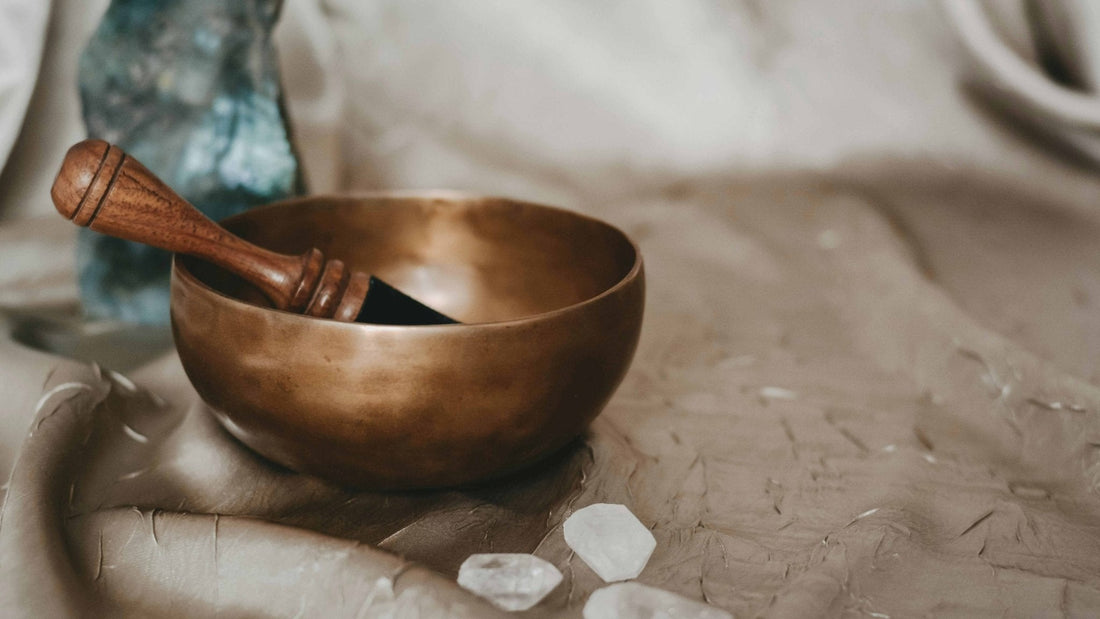
Crystal vs metal singing bowls
While the calming, hypnotic tones of singing sound bowls can bring deep peace, choosing between the two main types – crystal and metal singing bowls – can be a challenge. Each type offers unique benefits, sounds, and qualities that cater to different preferences and purposes. In this guide, we’ll explore the key differences between crystal vs metal singing bowls, examining their materials, history, and the healing powers they offer. Whether you're new to sound therapy or looking to expand your practice, this comparison will help you decide which bowl resonates best with your energy and needs.
What Are Singing Bowls Made Of?
Singing bowls are crafted from different materials, each bringing unique qualities to the sounds they produce. Metal singing bowls are traditionally made from a blend of seven sacred metals: gold, silver, copper, iron, tin, lead, and mercury. These metals are linked to celestial bodies, adding spiritual significance to their composition. However, modern metal bowls are more commonly made from bronze alloys, which maintain excellent sound properties while being more affordable and durable.
On the other hand, crystal singing bowls are made from 99.9% pure quartz, a high-vibration crystal known for its powerful healing energy. These bowls are formed by heating crushed quartz to extremely high temperatures, creating their distinct, resonant tones.
What Are Metal Singing Bowls?
Metal singing bowls, commonly known as Tibetan or Himalayan bowls, have a rich history that spans thousands of years, with origins in regions like Tibet, Nepal, and India. Traditionally crafted from a combination of seven sacred metals – gold, silver, copper, iron, tin, lead, and mercury – these metals were believed to correspond to the planets and celestial bodies, infusing the bowls with spiritual significance. Historically, metal bowls were used in religious and cultural ceremonies for meditation, prayer, and healing.
Their unique composition allows metal singing bowls to produce deep, harmonious overtones, which are highly valued in sound therapy and meditation. Known for their durability, these bowls can withstand frequent use and remain a staple in both traditional and modern healing practices. Today, many bowls are made from bronze alloys, preserving their powerful acoustic properties at a more affordable cost.
What Are Crystal Singing Bowls?
Crystal singing bowls are a more recent innovation, first created in the late 20th century. Unlike their metal counterparts, they are made from 99.9% pure quartz, a healing crystal known for its ability to amplify energy and clear negative vibrations. This high-vibration material allows crystal bowls to produce higher sound frequencies, which many believe can promote deep healing and balance in the body’s energy centres.
These bowls are also prized for their aesthetic appeal, often available in a variety of colours such as purple, blue, white, and more. Their shimmering tones and long-lasting vibrations make them popular in modern sound healing and meditation practices. Crystal bowls blend both acoustic and crystal healing, creating a powerful tool for spiritual wellness.
Differences Between Metal and Crystal Singing Bowls
When comparing crystal vs metal singing bowls, one of the most notable differences lies in their sound characteristics. Metal bowls, like Tibetan and Himalayan bowls, produce intricate, layered overtones that create a harmonious and soothing sound. These sounds are often softer and more complex, making them ideal for meditation and spiritual practices. In contrast, crystal singing bowls generate higher frequencies with clear, resonant tones that tend to last longer, creating a more profound and ethereal sound experience.
In terms of durability, metal singing bowls are generally more robust and less prone to damage from everyday use. Crystal bowls, while sturdy, are more fragile and can crack or break under high pressure or if mishandled.
Regarding cost, crystal singing bowls are typically more expensive due to the material (99.9% pure quartz) and their intricate manufacturing process.
Both types of bowls offer powerful healing benefits, but crystal bowls combine acoustic and crystal healing properties, amplifying their vibrational impact on the body’s energy systems.
| Type | Material | Sound Characteristics | Durability |
|---|---|---|---|
| Crystal | 99.9% Pure Quartz | High-frequency, resonant, long-lasting tones | Fragile, prone to cracking |
| Metal | Bronze or Sacred Metals | Layered, harmonious overtones | Durable, withstands frequent use |
Which Should You Choose?
When deciding between a crystal or metal singing bowl, your choice should depend on your personal preferences, intended use, and budget. If you’re looking for intricate, harmonious tones and a bowl that’s durable and easy to transport, a metal singing bowl may be the best fit. Metal bowls are often more affordable and come in a wide range of sizes.
On the other hand, if you prefer higher vibrational tones and want to combine crystal healing with sound therapy, a crystal singing bowl is a powerful choice, though it’s generally more expensive and fragile. Both types are highly effective for meditation, sound therapy, and healing, so it ultimately depends on what resonates most with your energy and needs. If you're new to singing bowls, check out our beginners guide to choosing a singing bowl to help you get started.
We encourage you to explore both options to find the one that best supports your sound healing journey.
Ready to begin your healing journey? Mindful Store is your one stop shop for meditation products, offering authentic Tibetan singing bowls handcrafted by artisans in Nepal. Explore our curated collection and bring the power of sound healing into your home today!
